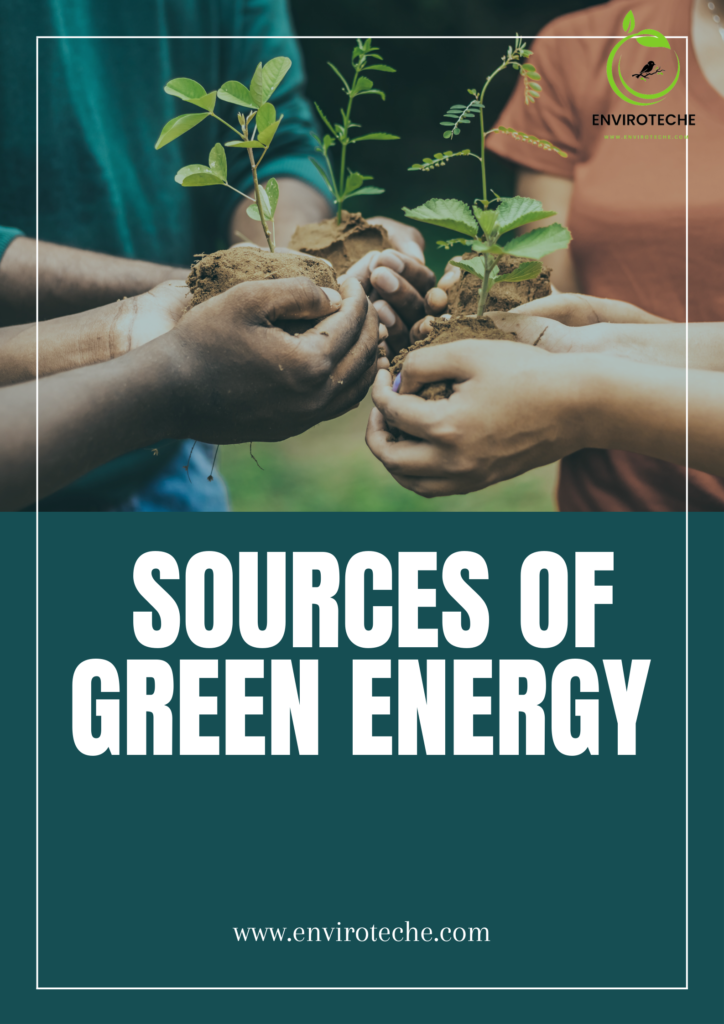Table of Contents

What is Green Energy?
Green energy encompasses energy derived from natural sources like wind, sunlight, or water. Despite the renewability of energy sources, not all renewable qualify as green; for instance, large-scale hydropower facilities can pose environmental challenges. Nevertheless, because green energy sources produce electricity with minimal greenhouse gas emissions, they are recognized as clean energy.
As per the Environmental Protection Agency (EPA), green energy offers the most significant environmental advantages, encompassing electricity generated from sources such as solar, wind, geothermal, biogas, low-impact hydroelectric, and specific eligible biomass sources. Green energy involves harnessing power from sustainable sources, avoiding carbon emissions, and minimizing environmental harm (Azam et al., 2023).
Green and Renewable Energy:
Green energy stems from natural sources such as the sun, clean energy is distinguished by the absence of air pollutants, and renewable energy is sourced from continually replenished reservoirs. While many renewable energy sources are environmentally friendly, not all of them are classified as entirely green. Wind power is environmentally friendly and sustainable, while burning wood is renewable due to the ability to grow more trees but lacks ecological friendliness as it releases pollution into the atmosphere. The ultimate objectives of renewable and sustainable energy sources are the same: lowering emissions of greenhouse gases and halting climate change.
Types of Green Energy:
- Hydropower:
Hydropower, a renewable energy source, produces electricity by capturing the movement of water in dams, rivers, streams, and various settings. It can also be harnessed on a smaller scale through processes like evaporation, rainfall, and ocean tides, as well as water flow in household pipes. Thanks to water’s high density compared to air, even a modest water stream can yield a significant amount of energy (Rahman et al., 2022). Various forms of hydropower, such as ocean energy, micro-hydro, hydroelectric energy, and dam-less hydropower, contribute to 20% of the world’s current electricity production.
Hydropower’s Impact on Environment:
Hydropower exerts significant environmental effects, primarily attributable to habitat loss and fragmentation stemming from impoundment reservoirs and associated dam construction and maintenance infrastructure. Dams impede animal migration, disturb river dynamics, and establish uniform conditions that may benefit non-native species. Additionally, hydropower contributes to greenhouse gas emissions, particularly methane, with heightened impact observed in tropical regions.
- Wind power:
Wind power involves transforming the energy from the wind into either electrical or mechanical energy through the utilization of turbines. Dating back 4000 years, the Chinese harnessed the wind to pump water for crops, while sailors utilized it for global navigation. Ideal locations for constructing wind turbines include coastal areas, hilltops, open fields, or any place with consistent and strong winds (Jurasz et al., 2020).
Wind power’s effect on the Environment:
Wind power annually contributes to the mortality of around 100,000 birds and bats, impacting migratory patterns and leading to population declines. Additionally, wind turbines can elevate ambient temperature and generate noise, negatively affecting certain native species.
Solar Power:
Solar power is a sustainable energy source derived from the sun to generate electricity or thermal energy. It is abundant and environmentally friendly, unlike fossil fuels, although it poses certain challenges. The main approaches for harnessing solar energy are photovoltaics and concentrated solar power. Solar energy, an immensely abundant resource on Earth, holds significant potential. In 2022, global electricity consumption reached approximately 25,500 terawatt-hours, yet the National Oceanic and Atmospheric Administration revealed that our planet receives a staggering 173,000 terawatts of solar energy continuously—over 10,000 times the world’s total energy usage. Harnessing solar power provides an inexhaustible and renewable energy source, ensuring a constant supply as long as the sun endures.
Impact on Environment:
Solar energy systems can generate electricity in various climates; however, a drawback is their susceptibility to brief weather disruptions. Cloudy days result in decreased electricity generation, whereas cold weather does not impact output (Jacobson & Delucchi, 2011). Despite being a rapidly advancing renewable source, the effects of solar energy are not fully understood, emphasizing the importance of further research in this field.
Advantages Of Green Energy:
Green energy has many advantages which are the following:
- Renewable energy offers an endless and clean power source with zero carbon emissions, fostering energy independence and self-sufficiency.
- Embracing sustainability, proves environmentally friendly, curbing climate change.
- Opting for green electricity and gas not only protects the environment but also leads to cost savings on your bills.
- Produces minimal to no harmful emissions.
- Easily accessible and, more importantly, readily renewable.
- Improved reliability, particularly in harsh weather conditions where a green energy source proves more dependable.
- Green renewable energy avoids the release of harmful pollutants, with many emitting none at all.
- Green energy stands out for its environmental friendliness.
- Public health benefits can be amplified through the use of renewable energy.
- Utilizing green energy, derived from sources such as wind, sunlight, and water, diminishes our reliance on foreign imports like oil, as these renewable are typically locally available.
Disadvantages Of Green Energy:
- Production of renewable energy frequently damages wildlife and ruins habitats.
- Solar panels displace animals from their natural habitats as they consume substantial amounts of space.
- Recycling is necessary for devices that harness renewable energy.
- Costly to stabilize.
Need of Developments in Green Energy:
The absence of energy access impacts every aspect of development, quality of life, and health of individuals as well as communities (including various aspects such as economic, social, and environmental issues). This includes improved standards of living, such as increased food production, improved industrial production, and the means for transport, building shelter, health services, and other human services, energy is needed for all these purposes.
Hence, it is of great essence to offer sustainable energy for sustainable economic and social development (Panwar et al., 2011). These challenges combined call for a transition towards renewable sources of the “low-carbon” energy sector, that is, the Green Economy. Economies and green growth agendas are necessary for all developing countries.
Sustainability of Green Energy:
It has caused an extreme illusion that renewable energy can totally substitute for non-renewable energy. It is becoming attached to huge existing demand-driven, fossil fuel-based energy development systems. Efforts of fuel conservancy appear as little returns because drivers decide not to save due to better conditions or just drive even more in these cars.
Why Green Energy Is Important?
Green energy plays a crucial role in environmental preservation by substituting the detrimental impacts of fossil fuels with eco-friendly alternatives. Originating from natural sources, green energy is frequently renewable and environmentally clean, emitting minimal or no greenhouse gases, while being readily accessible.
Conclusion:
Ensuring a sustainable future energy supply requires collective responsibility for judicious energy usage. Conservation and efficiency should be embraced by all. Environmental impacts necessitate a shift towards renewable sources like solar, wind, geothermal, wave, and hydropower. Despite this, the interim reliance on fossil fuels and nuclear energy persists until cleaner alternatives can fully take over.
Green energy sources, when considering their entire life cycle, emit significantly fewer greenhouse gases than fossil fuels and exhibit minimal levels of air pollutants. This not only benefits the planet but also promotes better air quality, positively impacting the health of both people and animals.
References
Azam, W., Khan, I., & Ali, S. A. (2023). Alternative energy and natural resources in determining environmental sustainability: a look at the role of government final consumption expenditures in France. Environmental Science and Pollution Research, 30(1), 1949-1965.
Jacobson, M. Z., & Delucchi, M. A. (2011). Providing all global energy with wind, water, and solar power, Part I: Technologies, energy resources, quantities and areas of infrastructure, and materials. Energy policy, 39(3), 1154-1169.
Jurasz, J., Canales, F., Kies, A., Guezgouz, M., & Beluco, A. (2020). A review on the complementarity of renewable energy sources: Concept, metrics, application and future research directions. Solar Energy, 195, 703-724.
Panwar, N. L., Kaushik, S. C., & Kothari, S. (2011). Role of renewable energy sources in environmental protection: A review. Renewable and Sustainable Energy Reviews, 15(3), 1513-1524.
Rahman, A., Farrok, O., & Haque, M. M. (2022). Environmental impact of renewable energy source based electrical power plants: Solar, wind, hydroelectric, biomass, geothermal, tidal, ocean, and osmotic. Renewable and Sustainable Energy Reviews, 161, 112279.
Author detail:
Tehreem Tahir, Aisha Ghaffar
Department of Chemistry, University Of Agriculture Faisalabad, Sub-Campus Toba Tek Singh
Check Other Scholarships:

